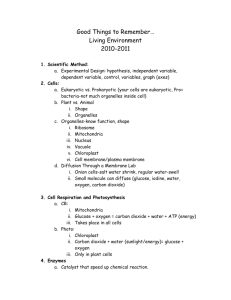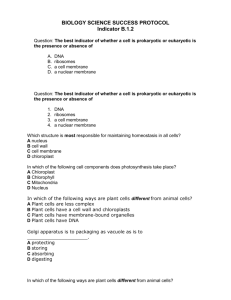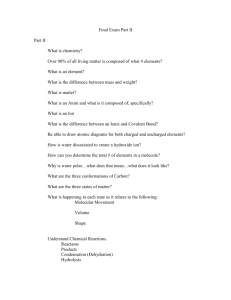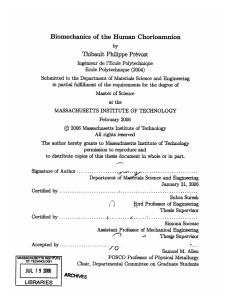extra credit-3rd quarter
advertisement
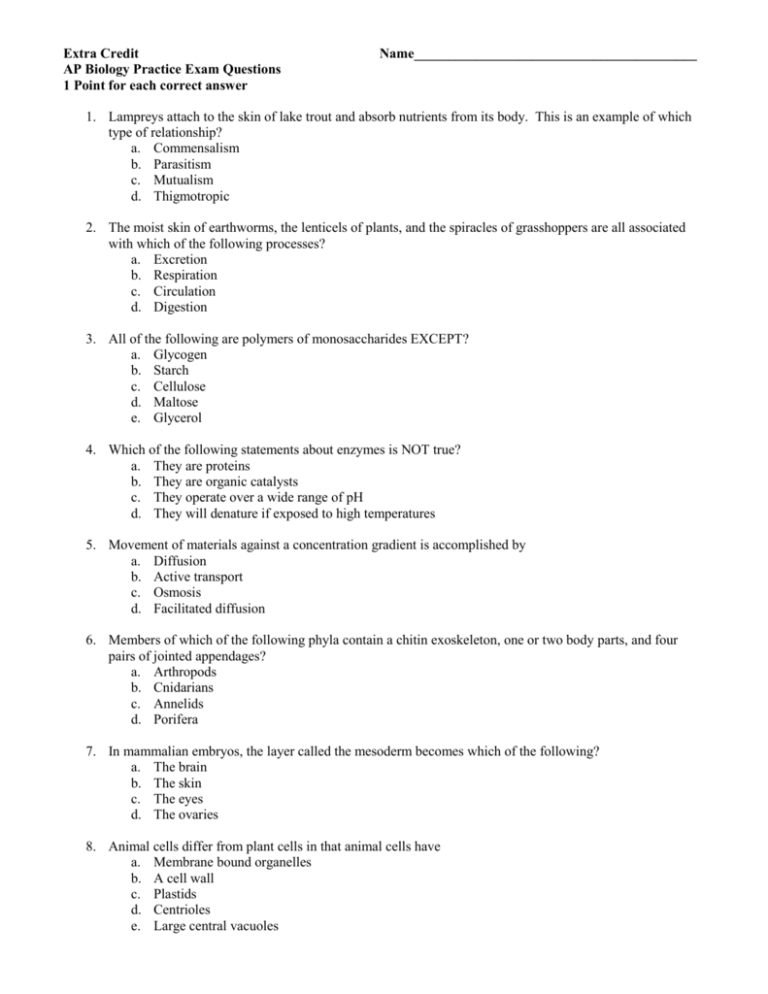
Extra Credit AP Biology Practice Exam Questions 1 Point for each correct answer Name_________________________________________ 1. Lampreys attach to the skin of lake trout and absorb nutrients from its body. This is an example of which type of relationship? a. Commensalism b. Parasitism c. Mutualism d. Thigmotropic 2. The moist skin of earthworms, the lenticels of plants, and the spiracles of grasshoppers are all associated with which of the following processes? a. Excretion b. Respiration c. Circulation d. Digestion 3. All of the following are polymers of monosaccharides EXCEPT? a. Glycogen b. Starch c. Cellulose d. Maltose e. Glycerol 4. Which of the following statements about enzymes is NOT true? a. They are proteins b. They are organic catalysts c. They operate over a wide range of pH d. They will denature if exposed to high temperatures 5. Movement of materials against a concentration gradient is accomplished by a. Diffusion b. Active transport c. Osmosis d. Facilitated diffusion 6. Members of which of the following phyla contain a chitin exoskeleton, one or two body parts, and four pairs of jointed appendages? a. Arthropods b. Cnidarians c. Annelids d. Porifera 7. In mammalian embryos, the layer called the mesoderm becomes which of the following? a. The brain b. The skin c. The eyes d. The ovaries 8. Animal cells differ from plant cells in that animal cells have a. Membrane bound organelles b. A cell wall c. Plastids d. Centrioles e. Large central vacuoles 9. Under favorable conditions, bacteria divide every 20 minutes. If a single bacterium replicated according to this condition, how many bacterial cells would one expect to find at the end of three hours? a. 32 b. 64 c. 128 d. 256 e. 512 10. Which of the following are characteristics of both bacteria and fungi? a. Cell wall, DNA, cell membrane b. Nucleus, organelles, unicellular c. Cell membrane, multicellular, Golgi apparatus d. Cell wall, RNA, mitochondria e. Nucleus, DNA, cell wall 11. The two components of a virus are a. DNA and lipids b. Nucleic acid and protein coat c. DNA and cell membrane d. RNA and cell wall e. Nucleic acid and cell membrane 12. The scientific name for the fruit fly is Drosophila melanogaster. The word Drosophila refers to the classification group known as a. Species b. Genus c. Class d. Family e. Phylum 13. A population of paramecium has the scientific name P. aurelia whereas another population has the name P. caudatum. The organisms do NOT belong to the same a. Class b. Family c. Genus d. Species 14. Which of the following represents the correct sequence of events in embryonic development? a. Blastula-cleavage-morula-gastrula-neurula b. Blastula-neurula-cleavage-morula-gastrula c. Cleavage-morula-blastula-neurula-gastrula d. Cleavage-morula-blastula-gastrula-neurula e. Morula-blastula-gastrula-cleavage-neurula 15. In humans, dizygotic twins (non-identical) develop when a. A diploid cell rapidly divides and splits into two cells b. A fertilized ovum splits at an early stage of development c. Two identical oocytes are fertilized by two different sperm d. Two different oocytes are fertilized by two different sperm 16. Crossing over during meiosis permits scientists to determine a. The rate of variation in zygotes b. The rate of mutations c. Chromosome mapping d. Which traits are dominant or recessive 17. In reptile eggs, the extra-embryonic membrane that functions in excretion and respiration is the a. Amnion b. Chorion c. Allantois d. Yolk sac 18. This forms the fluid-filled chamber in which a reptile embryo develops. a. Amnion b. Allantois c. Chorion d. Yolk sac Questions 19-22 a. sporulation b. budding c. regeneration d. binary fission e. vegetative propagation ______ 19. Asexual reproduction done by bacteria. ______ 20. The regrowth of severed appendages in lower animals. ______ 21. Asexual reproduction in yeasts where smaller cells grow from the side of a parent cell. ______ 22. Asexual reproduction in which new plants develop from roots, stems or leaves of the parent plant 23. In some species it is possible for an egg to develop even if it is not fertilized (such as in drone bees.) This process is known as a. Parthenogenesis b. Meiosis c. Embryogenesis d. Regeneration 24. Memory loss would most likely be due to a malfunction of which part of the brain? a. Medulla b. Cerebrum c. Cerebellum d. Hypothalamus 25. All of the organs in the digestive system secrete digestive enzymes EXCEPT the a. Mouth b. Stomach c. Small intestine d. Gall bladder 26. A scientist carries out a cross between two black guinea pigs. Black hair is dominant. The offspring of the cross have a phenotype ratio of ¾ black and ¼ white. The genotypes of the parents are most likely a. Bb x bb b. Bb x Bb c. bb x bb d. BB x bb 27. Which of the following is a characteristic of arteries? a. They are thin walled blood vessels b. They contain valves which prevent the backflow of blood c. They always carry oxygenated blood d. They carry blood away from the heart 28. During strenuous muscle exertion, an insufficient supply of oxygen will lead to a build up of a. Lactic acid b. Pyruvic acid c. Acetyl CoA d. Ethanol 29. Which structure in an earthworm has a function similar to that of the alveoli in humans? a. Nephridia b. Flame cells c. Gills d. Skin 30. At times, a freshwater ecosystem undergoes changes in nutrient levels. An algal boom is most likely a result of a. Eutrophication b. Succession c. Lake turnover d. Greenhouse effect 31. The sliding action of actin and myosin in skeletal muscle contractions requires a. Na+ b. ATP c. Water d. NADP 32. Chemical substances released by organisms that elicit a physiological or behavioral response in other members of the same species are known as a. Auxins b. Hormones c. Pheromones d. Enzymes 33. Which of the following is an adaptation of flowering plants living in an arid climate? a. Vascular tissue b. More stomata c. More leaves d. Thicker cuticles 34. Plant hormones which promote elongation of the stem are a. Cytokinins b. Auxins c. Gibberellins d. Abscisic acid 35. Plants that have floral parts which occur in multiples of three, vascular bundles that are scattered in the stem and leaves with parallel veins are a. Mosses b. Liverworts c. Monocots d. Eudicots 36. In most plants, germination of seeds is triggered by the presence of a. Water, oxygen, and light b. Light, water, and soil c. Carbon dioxide, water, and soil d. Oxygen, water and temperature e. Carbon dioxide and light 37. The similarities between the arm of a human, the fin of a whale, the foreleg of a dog and the wings of a bird provide support for the concept of a. Survival of the fittest b. Acquired characteristics c. Common ancestry d. Reproductive isolation e. Convergence 38. If the genotype frequencies of an insect population are AA = 0.49, and aa = 0.09, what is the gene frequency of the dominant allele? a. 0.07 b. 0.30 c. 0.49 d. 0.50 e. 0.70 39. In a diploid organism with the genotype AaBbCCDDEE, how many genetically distinct kinds of gametes would be produced? a. 4 b. 8 c. 16 d. 32 40. The length of DNA molecules is measured in base pairs. Which of the following ratios would you expect to remain constant in the DNA? a. Cytosine / adenine b. Pyrimidine / purine c. Adenine / phosphate d. Guanine / deoxyribose

